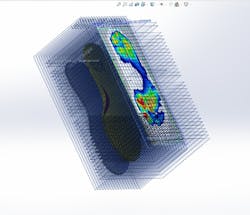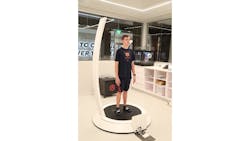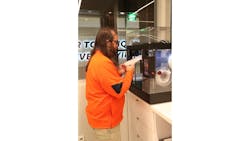Novel 3D Imaging System Helps Optimize Athletic Performance from Head to Toe
Current-day athletes have one significant advantage over the greats of the past—technology. Advanced technologies such as artificial intelligence-enabled software, 3D imaging and simulation software, and powerful industrial computers eloquently track fluid dynamics and body motion, providing data that can improve performance in sports ranging from football to gymnastics.
Capturing realistic simulations of a human athlete’s complex movements presents challenges. Falcon Pursuit’s (Portland, OR, USA; www.falconpursuit.com) Athlete-Avatar system meets this challenge and combines 3D simulation software, 3D cameras, AI-enabled software, and industrial PCs to effectively capture data and create full-body, 3D avatar technology with data athletes can use to reach new performance heights. The system was recently deployed at Auburn University.
Building an Avatar
By simulating the effects of fluid flow over a model of an athlete, Athlete-Avatar users can create complete athletic performance profiles as athletes train. Creating a 3D model of an athlete using CAD software might take days, but coaches and athletes need this data in just minutes. 3D imaging technologies can cut down on this time by producing point clouds of millions of data points that allow engineers to quickly generate accurate digital athlete models (or “avatars”) for use in fluid dynamics software that delivers data in just minutes.
Falcon Pursuit’s 3D simulation software and AI-software framework streamlines the process of creating athlete avatars by leveraging point cloud data and a library of high-fidelity avatars to analyze athlete movements in 3D space with accurate computational air and fluid monitoring. Athletes step into a kiosk for 3D scanning and a system operator selects a base avatar with a full structure of muscles and bones from the library. The point cloud generated by the scan wraps around the “skin” of the avatar.
Tracking each individual piece of data is not necessary. After saving the avatar, the software removes the point cloud, significantly cutting down on processing time. The software, however, maintains the complex shape and accurate movement of the athlete. By providing more flexibility and information on drag, this approach ensures that the avatar moves more elegantly and realistically than avatars created by scans or STL files.
3D Vision, 3D Printing Take System to New Heights
The generation-two kiosk features seven Structure Core 3D sensors from Occipital (Boulder, CO, USA; www.occipital.com), each with stereo infrared cameras, an RGB camera with 1280 × 960 resolution and 160° FOV, a NU3000 multicore processor from Inuitive (Raana, Israel; www.intuitive-tech.com), and 6-axis inertial measurement units. The system also uses four UI-5581LE board-level cameras from IDS Imaging Development Systems (Obersulm, Germany; www.ids-imaging.com), which include the 5 MPixel MT9P006STC color CMOS image sensor from onsemi (Phoenix, AZ, USA; www.onsemi.com) with 2560 × 1920 resolution and a proprietary lens that minimizes “flat view effect” for extremely close subjects. These cameras are embedded into two arms that move around the athlete’s body during the scan.
For the generation three kiosk—which is now installed at Auburn University’s new football facility—Falcon Pursuit replaced the seven 3D sensors and four 2D cameras with seven Intel (Santa Clara, CA, USA; www.intel.com) RealSense D435i depth cameras, which feature a global shutter sensor with 3.3 µm pixel size, 87° × 58° depth field of view, depth stream output resolution of up to 1280 × 720 at up to 90 fps, and a 1920 x 1080 RGB sensor resolution at a frame rate of 30 fps. In addition, all sensors are now embedded onto one arm that can scan athletes at heights of up to 7 feet, 6 inches, according to Jay White, CTO at Falcon Pursuit.
“Intel’s D435i sensors have a very effective RGB camera built in that automatically deposits the color exposure onto the 3D element of the structure, removing the need to do this afterward,” he says. “This also simplifies cabling and allows us to collect the same number of data points at speeds three times faster than the previous 3D sensor.”
Like the previous iteration of the kiosk, scanning takes place inside the kiosk, with the one arm rotating around the athlete to produce a digital rendering that offers precise modeling of the athlete from his form, figure, and 3D motion. The avatars produced by the software can be configured into hypothetical stances to test performance methods to deliver a new level of accuracy and flexibility to analyzing performance, drag, and other key performance indicators in 3D space.
As part of the overall system upgrade, the kiosk now offers foot mapping for custom insoles as well. Athletes stand on an ultrathin pressure-sensitive Mylar® device that maps their feet to create custom polyurethane insoles and pads using a nest of 3D printers at the Auburn University facility, according to White. “Not only do we have 3D information, but we can tell where an athlete’s metatarsal heads are touching the arch, how much pressure is on the calcaneus, and so on, which allows us to make a superior footbed,” he says. “Once the data have been captured, an equipment operations manager can simply enter the shoe size, click a button, and create insoles custom to a specific athlete that are ready to use.”
Six Times the Processing Power
At the heart of the system is the software. Falcon Pursuit’s proprietary AI framework interpolates 2D motion into 3D movement profiles, which reduces limitations and time in computational fluid dynamics while maintaining accuracy. Doing so, however, requires a powerful PC and a graphics processing unit (GPU) capable of handling the demands of the application. While Falcon Pursuit’s system offers significant speed upgrades over CAD-based alternatives, increasing the processing power and speeding up the process allows the system to deliver invaluable information for training strategies to coaches and players even faster.
To that end, White explains that the system has upgraded from a custom Nuvo-7000 PC from Neousys Technology (Northbrook, IL, USA; www.neousys-tech.com) that was customized by CoastIPC (Hingham, MA, USA; www.coastipc.com) to a Nuvo-9000 model featuring an NVIDIA (Santa Clara, CA, USA; www.nvidia.com) GPU. The new PC—which is also supplied and customized by CoastIPC — features an Intel 12th-gen Alder Lake Core processor, Neousys MezIO interface for easy function expansion, and a patented cassette for PCI/PCIe add-on card accommodation. “With the new industrial PC from our partner CoastIPC, the kiosk will have six times the processing speed of the previous model,” says White. “On top of that, we’ve opened up considerable more parallel processing, which equates to us chopping about 40 seconds off the avatar preparation time, so that the entire process takes place in about 90 seconds.”
Lowering the Barrier to Entry
By adopting novel technology like Falcon Pursuit’s Athlete-Avatar system, Auburn University has not only vital data that can inform coaching strategies and player execution but also the ability to create custom pads and insoles that can help with physical performance.
The system is also deployed by coaches across several different sports, including gymnastics. Prior to winning an Olympic Gold Medal in 2021, one athlete worked with her coach and Falcon Pursuit during training. During a full day, the athlete was scanned in the kiosk, allowing the system to perform advanced AI body motion analytics in beam, floor exercise, uneven bars, and vault training, which extracted full body rotations and skeletal positions to graphically display for the athlete to review minutes after finishing a routine.
In the past, deploying technologies for such applications may have seemed prohibitive in terms of the time, cost, effort, and expertise. But as technologies such as 3D sensing and AI-enabled software advance and become more well-defined, leveraging such systems becomes much more practical for athletes across the globe.


